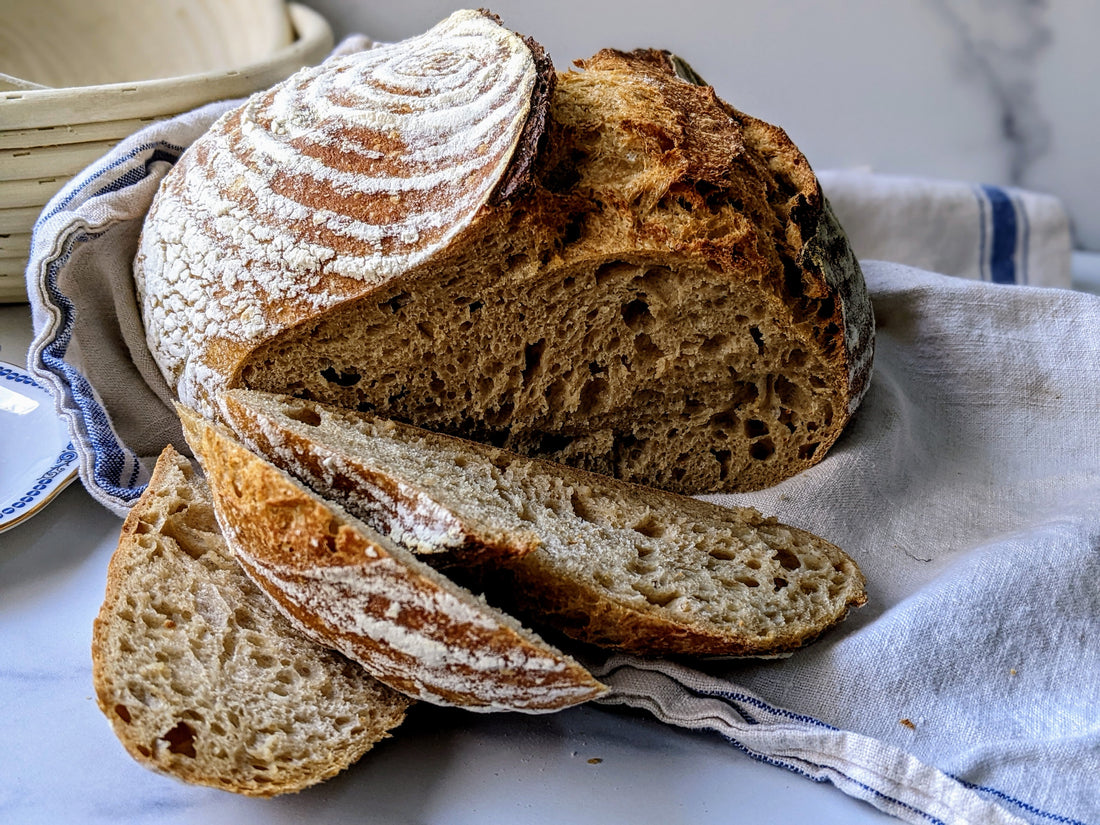
Einkorn Flour: An Ancient Grain with Modern Appeal
Share
In the world of artisanal baking, Einkorn flour has quietly carved out a niche for itself among health-conscious bakers and those intrigued by ancient grains. But what exactly is Einkorn flour, and how does it impact the texture and flavour of bread? Let’s explore the origins of this fascinating grain and what makes it stand out in the bakery.
What is Einkorn Flour?
Einkorn (Triticum monococcum) is one of the earliest forms of cultivated wheat, dating back over 10,000 years. Unlike modern wheat, which has been bred extensively for yield and gluten strength, Einkorn remains genetically unchanged. It has only 14 chromosomes, compared to the 42 chromosomes found in modern wheat. This makes it one of the simplest and most ancient wheat species still in use today.
Grown Bulgaria, Einkorn flour is milled from the tiny grains of this heritage wheat.
Nutritional Profile
Einkorn is prized for its superior nutritional value. It contains:
-
More protein and antioxidants than modern wheat.
-
Higher levels of carotenoids, which give the flour a subtle yellow tint.
-
Lower levels of gluten, which some people with wheat sensitivities find easier to digest (though it is not gluten-free).
Its unique nutritional makeup has made Einkorn flour a popular choice among those looking to bake healthier breads without sacrificing taste.
How Einkorn Flour Affects Bread Texture
If you're used to baking with all-purpose or bread flour, working with Einkorn is a different experience. Here’s how it affects the texture of your bread:
1. Low Gluten Strength
Einkorn contains gluten, but it's a much weaker form than that found in modern wheat. This impacts the dough’s ability to stretch and trap gas bubbles during fermentation.
Result:
-
Less rise during proofing.
-
Denser crumb compared to bread made with high-gluten flour.
-
A more compact, moist texture—think rustic rather than airy.
2. Sticky Dough
Einkorn dough is notoriously sticky. It absorbs water more slowly, and the proteins don't create the same kind of elastic gluten network.
Tips:
-
Use less water than you would in a standard bread recipe.
-
Expect the dough to feel more like a batter. Avoid over-kneading; Einkorn benefits from a gentler touch and shorter mixing times.
3. Tender and Delicate Crumb
Despite the lower rise, Einkorn bread has a surprisingly soft and tender crumb. The fine starch granules and high lipid content contribute to this melt-in-your-mouth texture.
4. Nutty, Buttery Flavour
Einkorn’s flavour is often described as nutty, sweet, and buttery—a far cry from the neutral flavour of white flour. This adds complexity and richness to bread, even with minimal ingredients.
Best Uses for Einkorn Flour
While Einkorn makes a beautiful rustic loaf, it's also great for:
-
Flatbreads and focaccia
-
Pancakes and muffins
-
Pasta and noodles
-
Cookies and quick breads
Because of its unique texture and baking behaviour, many bakers prefer to blend Einkorn with other flours for a more predictable structure—especially in recipes that require volume, like sandwich loaves.
Einkorn flour offers a delicious and nutritious alternative to conventional wheat. Baking with it requires a bit of a mindset shift, especially when it comes to texture and handling, but the rewards are significant. You’ll end up with loaves that are flavourful, nourishing, and deeply satisfying—rooted in thousands of years of tradition.
So pick up a bag of Love my Earth Einkorn flour and experiment. You might just fall in love with bread all over again.
🥖 Simple Rustic Einkorn Bread Recipe (No Knead)
Yield: 1 loaf
Time: ~5 hours (includes rising time)
Ingredients
-
300g whole grain Einkorn flour
-
120g strong bakers flour
-
1 ½ tsp sea salt
-
1 tsp instant yeast
-
1 ½ cups (360ml) warm water (100–105°F / 38–40°C)
-
1 tbsp honey
Instructions
1. Mix the Dough
In a large bowl, combine the flour, salt, and yeast. Stir in the warm water and honey until just combined. The dough will be sticky and wet—this is normal for Einkorn.
2. First Rise
Cover the bowl with a clean towel or plastic wrap and let it rise at room temperature for 3–4 hours, until puffy and slightly domed.
3. Preheat the Oven
Place a Dutch oven or heavy baking pot with a lid into your oven and preheat to 230°C. Let the pot heat for at least 30 minutes.
4. Shape the Dough
Dust a sheet of parchment paper with flour. Scrape the dough onto it and gently shape it into a round or oval—no kneading, just coax it into shape. Einkorn dough is fragile, so avoid deflating it too much.
Let it rest for about 30 minutes uncovered while the oven finishes preheating.
5. Bake
Carefully remove the hot Dutch oven. Lift the dough using the parchment paper and place it into the pot. Cover and bake for 25 minutes.
Remove the lid and bake for another 10–15 minutes, until the crust is deep golden brown.
6. Cool
Transfer the bread to a wire rack and let it cool for at least 1 hour before slicing. This helps the crumb set fully.
🍞 Tips for Success
-
Use less water than modern wheat recipes. Einkorn absorbs slowly.
-
Resist the urge to over-knead—it doesn't benefit Einkorn.
-
Expect a denser, moist crumb with a rich, nutty flavor.
Store the bread in a cloth or paper bag. Avoid plastic—it softens the crust.
